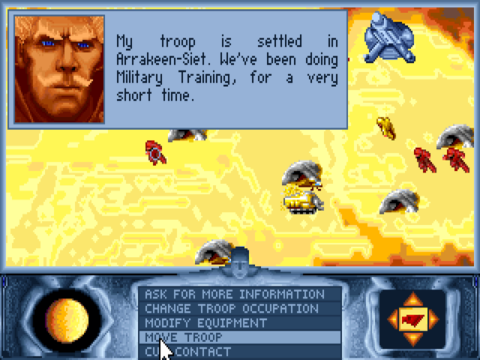
Dune
Written by: Rik
Date posted: June 11, 2023
- Genre: Strategy
- Developed by: Cryo
- Published by: Virgin Interactive
- Year released: 1993
- Our score: 8
Until recently, my knowledge of Frank Herbert’s Dune was gleaned entirely from the introduction to Westwood’s real-time strategy spin-off, Dune II: The Building of a Dynasty. While Denis Villeneuve’s recent cinematic take on the story did hold some appeal, as a man in his forties, the prospect of diving into a 2.5 hour film of an evening has become increasingly less appealing than an early night. Still, nothing focuses the mind quite like being sealed into a metal tube for 9 hours, and a recent long-haul flight provided an opportunity to experience this visual masterpiece via a small screen in the back of someone else’s headrest.
As well as correcting a few misconceptions about the world as presented by Dune II (House Ordos isn’t a thing? There’s no clean-cut blonde Mentat called Cyril?) I was surprised by the extent to which the film, and certain sequences in particular, stirred up feelings of fondness for something of which I only ever had a very distant and vague knowledge. Admittedly, it was the segments that drew direct parallels with the game – such as the view from above of a giant sandworm rumbling towards a spice harvester – rather than the political and spiritual aspects that I found most affecting, but it nevertheless provided a renewed incentive to revisit the world in gaming form.
As previously discussed, however, Dune II is out of the running, possibly forever, exiled to the Vault of Regret along with its spiritual successor Command & Conquer due to generalised and continuing incompetence on my part. Hence a return to this first tie-in, which I had always ignored previously due to a misconceived notion that it wasn’t all that well received at the time, a feeling bolstered by my long-held bias against French developers Cryo, fuelled by historical enmity towards their terrible MegaRace games. However, more contemporary research indicated some fairly widespread fondness for Dune, as well as the slightly surprising revelation that the sequel only ever came into being as a result of this title’s troubled development, causing publisher Virgin to panic and approach Westwood to develop an alternative spin-off, only for Cryo to pull things together and both games to ultimately be released.
If Dune II certainly isn’t an authentic follow-up to Dune, the two nevertheless have certain elements in common. Both have a strategic element and cast you in the role of one of the Dune Empire’s Houses, tasked with conquering not only the unforgiving wastes of the planet Arrakis, but any opponents that stand in your way. However, while Westwood’s title focuses exclusively on the business of base building, spice production and combat, Cryo’s effort maintains closer links with the novel by retaining more narrative, and allowing space for some of the mystical elements of the story.
Cast here in the role of Paul Atreides, just as House Atreides arrive on Arrakis, your initial task is indeed to mine the valuable spice, in accordance with the demands of Emperor Shaddam IV. To do this, you need to gain the trust and support of the native Fremen, located at nearby bases, known as sietches. What follows is a drip-drip combination of narrative and scripted events, as new characters and additional subtleties to the gameplay are gradually introduced. Recruit nearby Fremen and find some spice harvesters to perform mining more effectively, follow clues to establish the location of more sietches, and periodically return to the palace in order to receive messages from the Emperor and send him shipments of spice.
It can initially seem as if you’re being pulled from pillar to post and bombarded with different goings on. Events are fairly tightly controlled to start with, and at this point Dune may seem more like a first-person adventure game than anything else, as characters tell you to go to place X and speak to person Y, before you’re summoned back to the palace to receive more news and explanations. Your tolerance for this may vary, although personally I quite enjoyed the opportunity to get acquainted with both the story setup and the basics of gameplay, even if progress on the former comes more quickly than the latter. One key mechanic introduced at this stage is the notion of adding up to two non-player characters to your party, so they can advise you, advocate on your behalf, and/or act as lookout for new locations from the ornithopter, as you follow the vague directions given by the Fremen.
Frequent travelling is also baked into the game at this point, as Paul has to make the journey to each location by ornithopter at the outset, and return to already discovered sietches to receive updates and issue instructions to individual Fremen leaders in person. This has the added advantage of ensuring you keep in touch with them all, which is required to ensure their morale is maintained (‘It’s been days since we heard from you!’ is arguably the ‘yessir/acknowledged!’ of this pre-C&C title) but also ensures that you receive news of nearby sietches not yet discovered.
Discovering more of the map, prospecting land for spice, and then mining it, ideally with a harvester (and an ornithopter to keep watch for those pesky worms) is the initial goal, so you can make a semi-regular delivery to the Emperor in accordance with his demands, which – naturally – increase as time goes on. Again, you have to physically return to the Atreides palace to receive and acknowledge his messages, and get Duncan Idaho (here seemingly solely concerned with spice stocks and delivery) to accompany you to the message room. It can be a bit of a pain at times, but unless things are going seriously wrong for you in other aspects of the game, it shouldn’t be too hard to meet his demands. (There is the option to argue with or refuse his requests, which I never had call for, but apparently upsetting him too much results in him sending his hot-shot Imperial forces to Arrakis as punishment).
Dune is generally acknowledged to be a fairly gentle challenge, although for the record I should state that in my experience it is possible to make quite a bad mess of things due to some missteps early on. The speed of the narrative was sufficient to panic me into thinking I should be a bit more proactive than I needed to be, perhaps mindful of my inability to keep up with the pace of RTS games, including Dune II, with enemy forces attacking just as I put the finishing touches to some concrete foundations for my wind traps.
Time does march on here, particularly if you’re travelling around a lot, but in general there’s no massive need for urgency when pondering your next move (and you can always pause if you need more thinking time). However, beginning the combat element of the game before you’re ready, and/or mixing Fremen troops from different areas too early, can put you in peril – particularly as the game, which otherwise doesn’t steer you too far wrong – encourages you to do the former and fails to warn you about the latter. Far from securing steady progress through the early stages, my first attempt ended with some troops lost in battles they were never equipped for, while others downed tools after informing me of a previously unknown North/South divide among the Fremen.
Combat is indeed the next step, once you’ve got your spice production going steadily, although success seems largely contingent on hiding out away from the Harkonnen front lines while your men become sufficiently well trained to have a chance of completing espionage missions, finding Harkonnen bases, and then actually attacking them. Another Atreides advisor, Gurney Halleck, can speed up this process if he’s in the same sietch as the training Fremen.
As your territory expands, Paul will concurrently become more in touch with his Fremen side, bestowing handy powers such as the ability to communicate telepathically with sietches within a certain range and inspire greater loyalty amongst your troops, as well as a healthy number of breathless comments from other characters about how you’re some kind of saviour. (Apologies if you consider that a spoiler, but you get those vibes pretty early on in the game, even if you aren’t familiar with the story at all).
After a certain point, the narrative goes fairly quiet and you’re left alone to get on with the business of conquering/freeing Arrakis, with the only other major interlude being the introduction of ecology as a third occupation for your Fremen colleagues to busy themselves with, once you meet Liet Kynes and discover that there is a way to collect water and bring greenery to this desert land. Ecology mainly seems to serve as a morale booster, as well as a deterrent for the Harkonnen to attack those sietches, as cultivating plant life immediately destroys any spice in that territory, although I understand there is also a way to win the game by eschewing combat and terraforming the planet.
Other than the couple of previously-mentioned hiccups (which may well be particular to me or other similarly intellectually challenged gamers), the other main tussle is with the interface. Various idiosyncrasies take some getting used to, particularly the fact that Fremen troops can only do one thing at a time and move fairly slowly, and setting that against the general adrenaline of wanting to progress and get the next part of your plans set up and executed. Moving equipment was a personal bugbear: you can either send a troop with spare kit to another sietch and manually reallocate it to the troop already based at that sietch, or issue a generic instruction for the latter to ‘search for equipment’, at which point they’ll head to nearby locations, pick up anything they deem useful, and head back.
Having exclusively used the former method during the early exchanges, I then became puzzled when Fremen refused instructions to visit the neutral villages, home to smugglers of dubious moral fibre who will sell you harvesters, ornis and weapons for the right price (in spice, of course), despite those smugglers telling me to send someone in to collect my purchases. (It turns out you need to use the second method here). Having got over that little hurdle, I was then vexed by the hierarchy of weaponry which meant that a troop in possession of more advanced technology would still automatically look for a supply of the first available weapon, Krys knives, if they didn’t already have some, and wouldn’t budge if they didn’t think there would be any nearby (even when some unused heavy weapons, my intended target, were available locally).
That said, niggles are pretty minor overall, with other ones to throw into the mix including the apparent need to ensure your military troops are large (over 2000 seems to be the received wisdom, which I happened upon accidentally and followed, but I’m not sure how badly you come unstuck otherwise). Plus, during the transition from spice to combat and ecology I did also long for a bit of an easier way to summarise the size of each troop and what they were doing rather than clicking on them and going through the usual dialogue each time. And by the time the endgame arrives you might have put the narrative element of the game to the back of your mind to the extent that you forget that you might need to speak to a character in order to trigger it rather than endlessly searching the planet for Harkonnen forces that no longer exist (I could of course have referred to the secondary global map, of which I was completely ignorant until after the game ended, for clues as to overall progress).
I played the CD version, which comes with full voice acting (that adds plenty to the game) and various video clips (that, er don’t). The script contains a few snigger-worthy lines – “I am the Duke Leto Atreides, your father” is one – yes, Dad, please do remind me how we know each other – and there’s the weird juxtaposition of Fremen leaders who introduce themselves and mutter under their breath how you could be ‘the one’ only to then appear immediately reluctant to further satisfy their curiosity when you attempt to talk to them again, only responding with “Ehrrr…” However, it’s generally pretty effective stuff, with the slightly clipped overall tone and occasionally flowery declarations being in keeping with what I know of Dune, and the 2021 film, which arguably teetered just on the right side of taking itself too seriously.
Whether you need quite low quality clips from David Lynch’s 1984 movie incarnation, particularly the introduction by Virginia Madsen’s Princess Irulan (a character not actually featured in the game) that seems to duplicate a similar provision of context in the floppy disk version of the introduction that then follows, or indeed any of the others that are quite well hidden in the book/encyclopaedia section in a menu somewhere is another matter, although at the time I guess their inclusion would have been considered a major plus. So, too, would the looping pre-rendered flying sequences have been seen as a big upgrade from the sprite-based transitions of the disk version; these days, not so much.
Still, it all holds up remarkably well, both from an audio-visual perspective (the music is deceptively catchy) and as a hybrid of adventure/gentle conquer-the-planet strategy quest. It won’t test the tactical mettle of strategy veterans, or indeed anyone, for too long, but while it has you, it’s compelling stuff, passing the age-old test of making you defer something else you should be doing instead (even if these days it’s more ‘miss the dog’s tea-time by 15 minutes’ rather than ‘go to bed at 2am’).
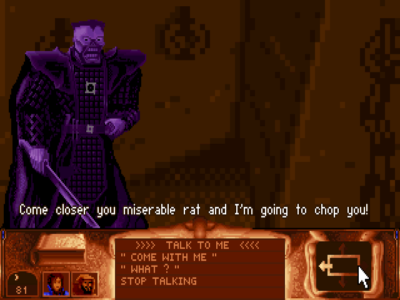
A captured Harkonnen leader. There’s nothing quite so reliably amusing as a briskly animated skeleton.
I completely overlooked Dune when it first came out, but even to someone with no prior knowledge or historical fondness to draw upon, it still manages to hold a certain magic. A glance at the archives confirms a wise man once told me that if I liked the old 16-bit classic Midwinter (which I did), then I should give this a try, and I’m very glad to have (eventually) done so.

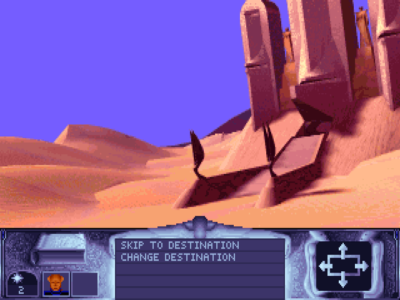
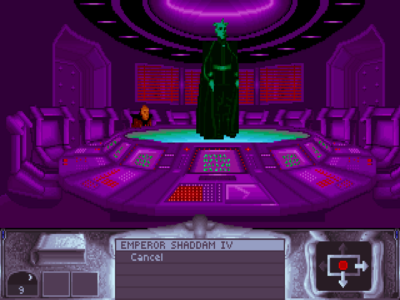
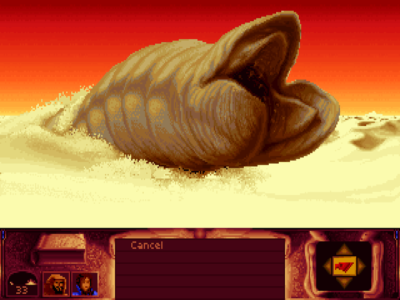
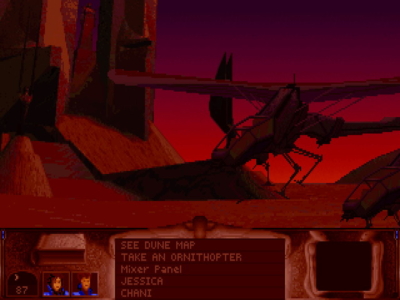
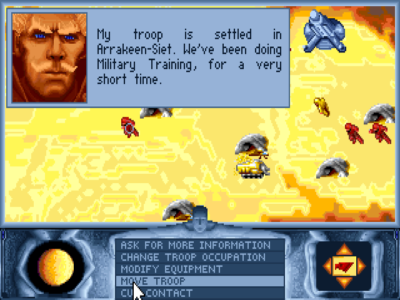

 Posts
Posts
Glad you enjoyed it!
June 13, 2023 @ 5:09 pm
Strategy game + MegaRace developers = 10 year delay.
June 15, 2023 @ 10:46 am